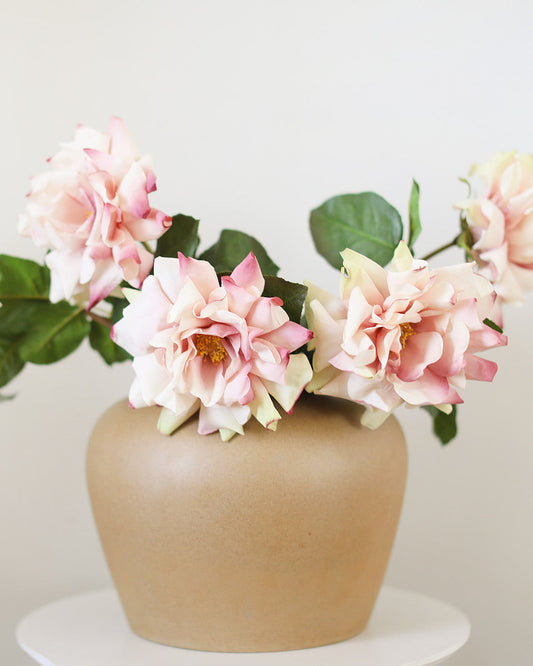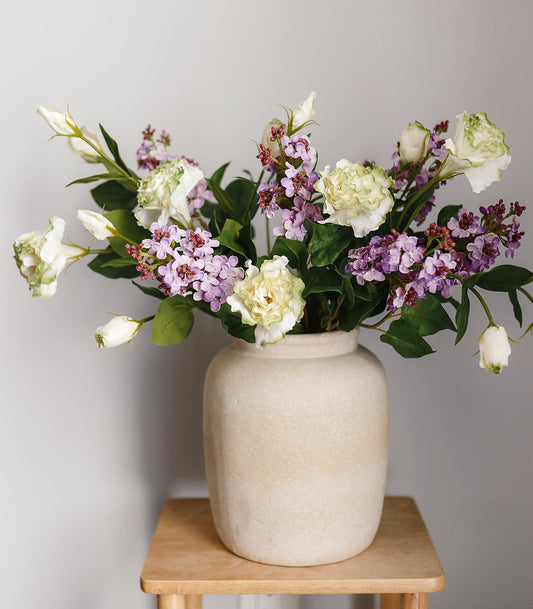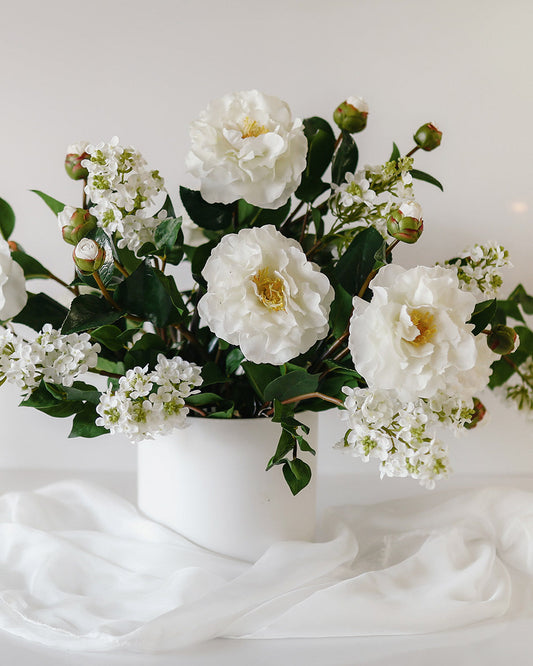From Stem to Style: DIY Flower Boutonniere

Crafting an artificial flower boutonniere is a beautiful way to add a personal touch to weddings, proms, or any special occasion. A handmade boutonniere is not only cost-effective but also allows you to tailor the design to match the event’s theme and colors - plus, you get the advantage of crafting your boutonnieres weeks or months in advance! In this guide, we’ll walk you through the steps to create a stunning DIY flower boutonniere, discuss the best flowers to use, and show some prime examples of when and where boutonnieres are used.
-
Artificial flowers
-
Faux greenery or leaves
-
Floral tape
-
Accents (berries, pearl sprays, crystals)
-
Ribbon (1/4” or 3/8” width works best)
-
Hot glue gun
-
Boutonniere pin or magnet
-
Floral cutters
-
Scissors

STEP-BY-STEP INSTRUCTIONS
STEP 1: SELECT YOUR FLORAL STEMS
Choosing the right flowers and greenery is important for creating a cohesive boutonniere(s). Keep in mind your event's theme, flower size, colors, etc. Here are some popular options for DIY flower boutonnieres:
Flowers:
-
Roses or Rose Buds (classic choice for weddings and proms - be sure to select a rose that isn't too large in size)
-
Small Tulip Buds
-
Ranunculus
-
Orchid Blossoms
- Lavender Sprigs
Greenery:
-
Eucalyptus
- Rose Leaves (or any leaf that naturally comes with the faux flower you have selected)
-
Pittosporum
-
Ferns
-
Succulents (small sedum clusters work great)
Accents:
-
Artificial Berries
-
Faux Hops
-
Baby’s Breath (or other smaller accent florals like lavender)
-
Pearl or Crystal Sprays (perfect for weddings and proms)
STEP 2: TRIM GREENERY
Choose a piece of faux foliage to frame and be the base/back for your flower boutonniere. Trim the stem to the desired length using floral cutters, usually about 2-3 inches. This step ensures the greenery doesn’t overpower the boutonniere and keeps the focus on the flower.

STEP 3: TRIM THE FLOWER(S)
Cut the main flower(s) stem to approximately 3-4 inches. This length ensures it’s manageable to work with and proportional to the boutonniere’s size. You can always trim these stems later on! Remove any thorns or leaves from the stem.

STEP 4: WRAP FLOWERS AND GREENERY
Place the flowers and greenery together, with the bloom resting on the front of the leaves. Hold the stems together and wrap them tightly with floral tape, starting just below the flower’s base. Stretch the tape slightly as you wrap to ensure it adheres securely - stretching floral tape activates the stickiness!


STEP 5: ADD ACCENTS
At this point, add in an accent pieces that you would like to use in your design. Place accents such as berries, flower buds, or decorative elements around the flower(s) and greenery. Get creative! Use accents on the sides, tuck behind the bloom, etc. Be mindful not to overcrowd the boutonniere — less is often more! Once you have the accent pieces where you want them, secure in place by wrapping them with floral tape. This also creates a nice, smooth base for the ribbon.


STEP 6: ATTACH FLORAL RIBBON
Choose a ribbon that complements the color scheme or your wedding, outfit, or special event. A 1/4” or 3/8” width ribbon works best for wrapping boutonniere stems. Some popular ribbon options are silk, satin, chiffon, velvet, and natural jute wrap.
Option 1: Full Ribbon Wrap
-
Start at the top of the stems and secure the ribbon with a dab of hot glue.
-
Wrap the ribbon tightly down to the bottom of the stems, curling it under to cover the stem ends.
-
Wrap back up to the top and secure with another dab of hot glue.

Option 2: Partial Stem Exposure
-
Starting at the bottom, leaving a small section of floral stems exposed.
-
Wrap upward to the top, securing the ribbon with a stylish knot for an organic look.

STEP 7: FINISH BOUTONNIERE WITH A PIN OR MAGNET
Attach a boutonniere pin or glue a boutonniere magnet to the back for easy fastening. Pins work well for jackets and heavier materials, while magnets are great choice for more delicate fabrics or dresses.


SEASONAL AND UNIQUE FLOWER TYPES
While roses and ranunculus are classic and common boutonniere choices, less "popular" flowers can still be a favorite and bring a unique, seasonal touch to your event. Here are some other faux blooms to consider:
-
Peony Buds: These compact, elegant buds are perfect for spring weddings and proms alike, offering a soft and romantic look. Pair these silk flowers with greenery like silver dollar eucalyptus or dusty miller.
-
Mini Sunflowers: Bright and cheerful, mini sunflowers work beautifully for rustic, summer-themed events, and of course, fall weddings! For a rustic look, pair with hops or berries, for summer - opt for a brightly colored ribbon, and for fall, why not add a traditional maple leave or 2 for a full autumnal feel.
-
Lilacs: Lilacs are a lovely choice for spring and into early summer occasions! Pair these little blossom beauties with soft grey green eucalyptus leaves, or other textural small blooms like sprigs of lavender.
POPULAR BOUTONNIERE STYLES
Boutonnieres can range from classic to creative, and everything in between! Here are just a few popular styles to inspire you:
-
Classic Single Bloom:
-
Features a single rose or carnation framed with greenery.
-
Ideal for traditional weddings or proms.
-
-
Rustic Elegance:
-
Incorporates earthy accents like twine, burlap ribbon, or berries.
-
Perfect for outdoor or barn weddings.
-
-
Modern Minimalist:
-
Focuses on sleek flowers like orchids or calla lilies with simple (or no) greenery.
-
Best for modern weddings or black-tie galas.
-
-
Whimsical and Wild:
-
Features asymmetrical designs with wildflower blooms like lavender or thistle.
-
Great for bohemian or eclectic themes.
-
-
Romantic and Lush:
-
Combine soft flowers like ranunculus, roses, or gardenia with greenery and pearl or crystal sprays.
-
Perfect for dreamy, romantic weddings and proms!
-
HOW TO WEAR A BOUTONNIERE
Floral boutonnieres are traditionally worn on the left lapel of a suit or jacket, above the heart. Use a 2" boutonniere pin to attach the boutonniere, inserting the pin from behind the lapel to keep it hidden. Boutonniere magnets offer an alternative for those who prefer a pin-free option, ensuring the boutonniere stays in place while protecting more delicate fabrics.
While boutonnieres are most commonly associated with and created for weddings and proms, did you know they are also suitable for:
-
Anniversaries: A thoughtful touch for milestone celebrations. Use flowers such as rose buds and tulips - you can also create your boutonniere with the flower that represents the anniversary you are celebrating.
-
Formal Galas: Adds polish and sophistication to black-tie events. Popular florals for this type of event include orchids, calla lilies, and black centered anemones.
-
Graduations: A way to honor graduates with a special floral touch. A common boutonniere style is a cream or white floral accented with a ribbon matching the graduation colors.
-
Military Balls: When creating boutonnieres for these events, incorporate meaningful flowers or accents.
BOUTONNIERE TIPS
Creating boutonnieres with artificial flowers comes with many advantages. Here are some tips to ensure your design turns out beautifully:
-
Choose High-Quality Faux Flowers: Opt for real touch flowers when you can ffor the most realistic appearance. When real touch florals are not an option, premium faux flowers will work just fine!
-
Avoid Bulky Stems: Faux flowers often have thicker stems. Trim them carefully and appropriately to ensure the boutonniere is lightweight and easy to wear.
-
Plan Your Design: Lay out your flowers, greenery, and accents before your final assembly to see what your design will look like. Play around with it if you need to!
-
Store Properly: Keep finished flower boutonnieres in a cool, dry place and out of direct sunlight to prevent dust, damage, or faded before your event.
By following these easy tips, your faux flower boutonnieres will not only look stunning but also last for years as keepsakes.
-------------
Making your own boutonniere is an experience that allows you to create ahead of time and add a personal touch into your special event. Whether for a wedding, prom, or other formal occasion, this DIY boutonniere guide will help you craft a stunning boutonniere that’s as unique as the memories you’ll create. Happy crafting!
Shop All Wedding Flowers from Prestige Botanicals.











